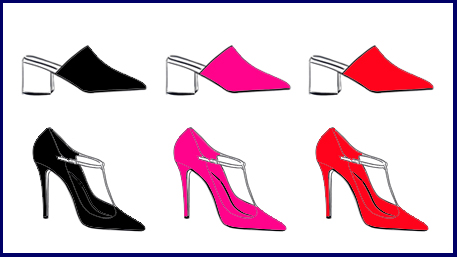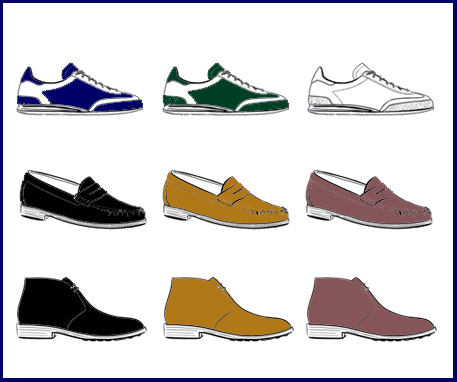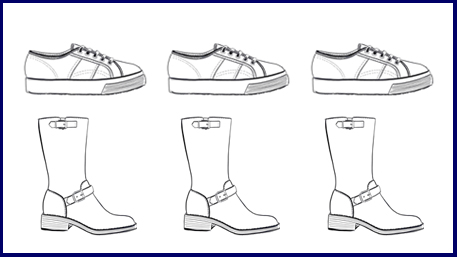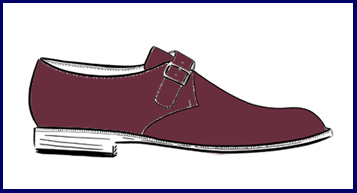How many shoes should I launch with?
There are three ways to look at building your launch collection, and I’m looking forward to sharing them with you. But first, a quick terminology crash course.

What is a SKU (and why does it matter)?
A SKU (stock keeping unit – I agree these three words provide no clarity!) is a colourway of a style. Why do I call it a colourway rather than a colour? Because sometimes we’re looking at a colour combination – like navy blue with a teal sole or pink and yellow leopard print – rather than a single colour.
You might decide in the future to offer two separate SKUs of your most popular colour e.g. Black Patent and Black Suede. SKUs differentiate by material too.
Examples:
- 1 style in 3 colourways/materials = 3 SKUs

- 2 styles in 3 colourways/materials each = 6 SKUs

Some buyers use the term “options” instead of SKUs.
Using the correct terminology matters because it reduces the possibilities for misunderstanding.
Examples:
- You brief your freelance shoe designer, telling them you want 5 styles in your range. They start designing with 5 styles as the end goal. They invoice you for this work. You then realise you should have communicated that you wanted 2 styles: 1 in 3 colourways, and the other in 2 colourways. So 5 SKUs, not 5 styles. A lot less work for a designer, and less expense for you.
- You have a meeting with a potential manufacturer, and you say you want them to make 6 styles. They agree to work with you on this basis, before realising you only meant 6 SKUs. They begin to wonder whether this range size will be worth their while, and wish they had the correct information when they agreed to be your manufacturing partner. The relationship gets off to a rocky start.
How do I decide how many shoes to launch with?
Here are the three scenarios for you to play with. Consider which of these will suit your customer’s shopping habits and desires.
1. Be your customer’s go-to shoe brand
This is the most difficult option to get right, but it could be a dream scenario for you and your customers. Imagine how easy it would be to only need to buy from one brand for all of the shoes you want! As a shoe brand founder, that kind of customer loyalty would be excellent for business. Especially if your fan base spreads the word.
Consider your customer’s wardrobe. Which outfits do they own, in which colours, and which 3-4 styles could replace your customer’s entire shoe collection (except perhaps running shoes and hiking boots)?

Make sure that your range covers all of your customer’s wearing occasions e.g. work, date night, evening event, wedding guest, casual weekend, kids party (cake-proof, so no suede). You might not design products for every single wearing occasion for your initial launch, but make a plan for when you would add these options e.g. sandals/flip-flops for beachwear in your second or third Spring/Summer season.
Creating a shoe range which complements all of your customer’s trouser and skirt lengths, colours in their wardrobe, and wearing occasions could take a lot of SKUs. That makes this option the most complex and will need the highest financial investment. Luckily, there are other options to consider.
2. Perfect your niche
Maybe instead of outfitting your customer’s entire wardrobe, you want to build a shoe line that is perfect for just one of your customer’s wearing occasions. Or has the versatility to traverse two. Perhaps comfortable but stylish women’s weekend shoe styles for summer and winter.

Alternatively, you could become the school run shoe brand – putting some joy into the hearts of dads and mums while they carry out this chore – and making sure they don’t have to change their shoes to switch into work mode.
3. One style: several colours
Don’t feel you have to launch your shoe brand with more than one style. Your customers don’t have to be offered multiple silhouettes to be able to buy one. Sometimes only one style makes sense, so don’t force a second into the mix. Focus your time on creating one excellent product in 3-6 colourways.

I read this article on FashionUnited recently, which talks about trend forecaster Li Edelkoort’s predictions for the future of fashion. The journalist writes:
“[Edelkoort] believes in the future of the monoproduct. She expects brands that focus on one product and perfect it to do well.”
As Edelkoort says, perfecting your product is the key to success here. Use customer feedback about your launch product to improve it. Decide when you want to launch version 2.0, 3.0 etc. so that you don’t hurry the process and confuse your customers. A customer is more likely to understand a product which has been improved in three ways, than one which has been tweaked, and will be slightly altered again in a month.
So those are the scenarios to consider when you are planning your first shoe range. Now read about a couple of other factors you will need to take into account.
How important is choice?
Too much choice can be confusing. Buying shoes online is hard because there are so many brands and retailers, each with hundreds of footwear options to choose from. It feels like hard work trying to find exactly what you want.

Avoid putting two similar options in your shoe range, because this makes your customer’s purchase decision almost impossible. They may be paralysed by the thought “What if I get it wrong?” or they might decide to order both styles and send one (or both!) back. It would be better for you not to pay for a customer return. Just make one good sale by ensuring your customer’s decision to buy is a no-brainer.
This article uses jam and crisps (not a serving suggestion!) to illustrate the need to provide fewer options.
“Contrary to popular belief, too many choices can be bad for sales. Just like in my experience in the chip aisle, customers can be attracted to a large number of choices, but when it comes time to make a purchase, too many options can make decision making difficult and lead to fewer sales.”
Balance your needs with your customer’s desires
After you have launched your first shoe range into the market, you will start receiving customer requests.
“I love this style, please can you make it in fuchsia with green spots?”
“This boot would be perfect if the laces were longer and it had hexagonal eyelets”.
It’s up to you which of those requests you incorporate into your range decisions.
One of the five amazing shoe brand founders I interviewed for my popular How to Start a Shoe Brand online course described her reaction to some customer feedback:
“[The customer] was frustrated of course that she wasn’t finding what she wanted but her question was “Why can’t I find Oxford or monk strap flat in red cordovan colour in 41 wide?” Her challenge was not just the size but wide and then a specific style and in cordovan red. I mean life is not perfect and we sometimes have to make choices. When I find that the style works, then I’m willing to bring in some other colours every season having that black in stock.”

The easiest way to decide which customer requests to act on is to collate them. List the suggestions in a spreadsheet, and note down every time someone else requests the same thing. Only add elements to your range that fit with your brand purpose, and that you are likely to sell enough of to make it worth your time and investment.
I hope this article has helped you make the important decision of how many shoe styles to design.
My How to Start a Shoe Brand online course gives you more enlightening stories about range planning from shoe brand founders, all of the templates you need including a range plan, and guidance on every single aspect of launching your own shoe line.
Please drop me a line if you have questions about the course!


Starting a shoe line, need your help.
Hello,
Thanks for your message. Yes I can certainly help you to develop your product and business.
I recommend that you enroll on my How to Start a Shoe Brand online course. It’s a comprehensive working guide which will set you up for launch.
Along with essential templates and worksheets, the course is packed with video content including guidance from me and many other industry experts and shoe brand founders.
I would also like to invite you to join The Shoe Community: an online space where shoe start-ups and small shoe brand founders help solve each others’ problems. Included in the price are regular masterclasses with shoe brand founders, Live Q&A sessions with me, and virtual community meet-ups.
Please do let me know if you have any questions about any of the above.
Thanks and best wishes,
Susannah